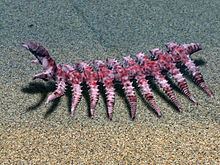Species †D. cactiformis Phylum †"Lobopodia" Rank Genus | Superphylum Ecdysozoa Scientific name Diania Higher classification Xenusiid | |
 | ||
Similar Diania cactiformis, Tamoya ohboya, Kerygmachela, Xenusiid, Luolishania | ||
Ufo diania 2016
Diania is an extinct genus of animal found in the Lower Cambrian Maotianshan shale of China, represented by a single species D. cactiformis. Known during its investigation by the nickname "walking cactus", this organism belongs to a group known as the armoured lobopodians and has a simple worm-like body with robust, spiny, and apparently jointed legs. Its significance is that jointed legs are the defining character of the arthropods and Diania may thus be very close to the origins of the most diverse group of animals on the planet.
Contents
- Ufo diania 2016
- Drviva mensina v centre diania uncensored
- Discovery
- Name
- Description
- Significance
- References
Drviva mensina v centre diania uncensored
Discovery
Fossils of these animals were discovered independently by Jianni Liu from the Northwest University (China) in Xi’an, Qiang Ou from the China University of Geosciences in Beijing and Michael Steiner of the Free University Berlin. The fossils come from the famous Chengjiang deposit – or Maotianshan shale – of south-west China and are about 520 million years old. Specifically, they come from the Yu'anshan Formation, dated to the Cambrian Stage 3.
Name
The name Diania comes from "Dian", which is an abbreviation in the Chinese language for Yunnan; the province where the fossils were discovered. The specific epithet cactiformis is based on its cactus-like appearance, which led to it being informally called the "walking cactus" by the research team working on the fossils.
Description
Complete fossils of Diania cactiformis are about 6 centimetres (2.4 in) long and have a long, thin body. At the front end is a proboscis, presumably used in feeding. These animals have ten pairs of legs, and compared to the body these are quite robust and spiny. Because of this spiny appearance in the rocks the animal became known informally as the "walking cactus". The most important aspect is that legs appear to be jointed, with a hard exoskeleton divided into ring-like articles.
Significance
Diania belongs to a group of extinct animals known as the armoured Lobopodia. These have long been assumed to be related in some way to Arthropoda and it seems likely that arthropods evolved from somewhere within this group. However, all previously discovered lobopodians showed soft, rather ring-like, but not segmented legs. The significance of Diania is that it is a lobopodian which appears to have evolved the name-giving character of the arthropods: jointed legs.
In the original description of the fossil the authors suggested that Diania could be the sister group of Schinderhannes and the remaining arthropods, but discussed the possibility that it may be a more primitive form emerging before the evolution of creatures like Kerygmachela and Anomalocaris.
Diania also suggests that that arthropodization (i.e. the appearance of hard, ring-like joints around the legs) evolved before arthrodization (i.e. hard, ring-like segments, around the body). However, the phylogenetic analysis underlying this conclusion was flawed.
